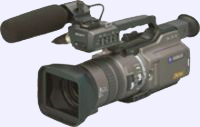|
ON THIS PAGE:
Technical info
Low light conditions
Sun light
Mixed light
Artificial light
|
 PART
10: LIGHTING PART
10: LIGHTING
by Christina
Fox
On the courses I run we don't give people lights. I don't believe you
can teach cameras and lighting in a week. Lighting is a specialised craft
plus there is a lot of health and safety issues tied up in lighting. But,
I do give some guidance of working without lights. Hence this section.
|
TECHNICAL INFO
Light levels are measured in LUX. The light given off by one candle at
12 inches (30cm) distance is equal to 10 Lux. The camera works best at
light levels in excess of 100 lux. But most can produce some sort of picture
down to a couple of lux.
Please note the camera manufacturers will boast about the amazingly low
light levels their cameras can work in - BUT all cameras only give
their highest quality pictures when the subject is correctly and adequately
lit. That said, it is not always possible to work in ideal lighting conditions.
Poorly lit areas and very bright sunny conditions both pose problems for
the camera operator.
Back to the top.
|
LOW LIGHT CONDITIONS
The camera is capable of producing pictures in very low
light conditions. To be able to do this the picture signal is electronically
boosted, which results in noisy, grainy, pictures. To prevent this loss
in picture quality you need to find some way of increasing the light hitting
your subject.
- Firstly ask yourself is it essential to do an interview indoors or
can it be done outside in daylight?
- Your eyes will deceive you. Look carefully at the location, is it
gloomy and under lit? If it is - move. Ask if there is another room
you could use which is better lit
- Sit your subject near to available light sources.
- Don't be afraid to re-arrange furniture, standard lamps and table
lamps to ensure your subject is lit. Anglepoise lamps can be particularly
useful.
- Sit your subject beside or facing a window to use the natural light
coming into the room.
- Remember blinds and net curtains reduce the light through the window
(ask if it is all right to move them out of the way during the shoot).
- NEVER sit your subject with their back to a window. If you do, your
subject will be in silhouette (fine if you want to keep their identity
a secret). The camera cannot correctly expose an unlit face against
a bright, sunlit, background.
Back to the top.
|
SUN LIGHT
- Remember - you have no control over the sun (and clouds) - sun light
levels can change dramatically - keep your finger on the exposure dial
and be ready to change F numbers!
- Sun light can be soft (when it is cloudy overhead) or hard (under
direct sun).
- Soft light can reduce wrinkles! it will make shots look flat and boring.
- Hard light can give harsh (unflattering) shadows on peoples faces
- but all photographers agree that you will probably take your best
shots when you have some shadow to play around with.
Back to the top.
|
MIXED LIGHT
- When you work in an area lit with more than one source of light e.g.
a room lit with light bulbs and with daylight coming through
a window - you need to give the situation some thought when white balancing.
- Always do a manual white balance when working in mixed light or your
pictures could end up with a strange colour cast, which you won't find
out about until it is too late. Take a white piece of paper and position
it so that it is lit with the same mix of light that your subject will
be lit by.
- Carry a few pieces of half-blue gel. You can place this over tungsten
light in order to convert it to daylight. Now you don't have
mixed light anymore.
Back to the top.
|
LIGHTING WITH ARTIFICIAL LIGHTS
I HOPE TO ADD SOME STUFF HERE IN THE NEAR FUTURE
If you want some lightweight lighting recommendation try my buying
guide
Back to the top.
©
2000 - 2010
|
- Move on to...
- Part 11: TROUBLE SHOOTING
- Or back to...
- Part 9: SOUND LEVELS
|
|
|
|
Christina Fox
|

